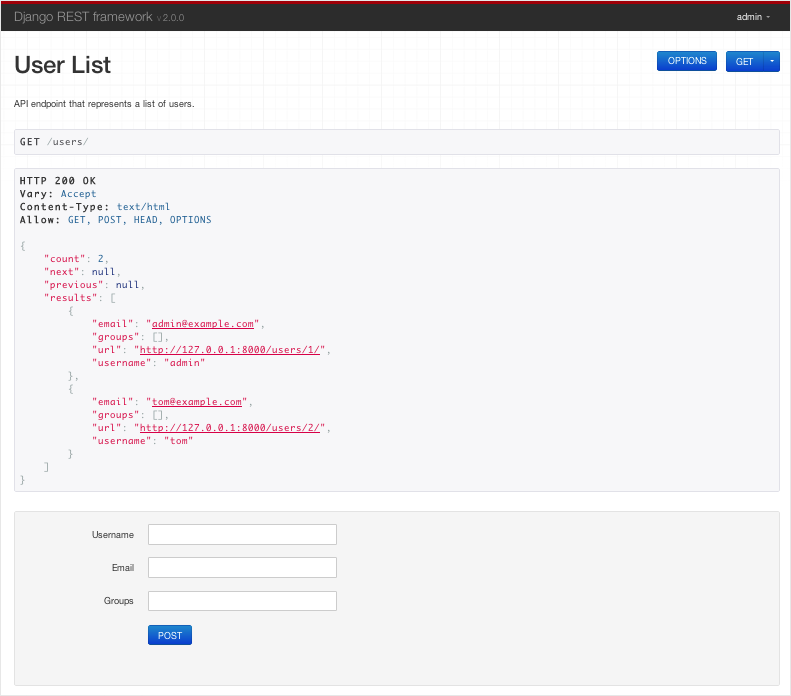Quickstart
We're going to create a simple API to allow admin users to view and edit the users and groups in the system.
Project setup
Create a new Django project named tutorial, then start a new app called quickstart.
# Set up a new project
django-admin.py startproject tutorial
cd tutorial
# Create a virtualenv to isolate our package dependencies locally
virtualenv env
source env/bin/activate # On Windows use `env\Scripts\activate`
# Install Django and Django REST framework into the virtualenv
pip install django
pip install djangorestframework
# Create a new app
python manage.py startapp quickstart
Next you'll need to get a database set up and synced. If you just want to use SQLite for now, then you'll want to edit your tutorial/settings.py module to include something like this:
DATABASES = {
'default': {
'ENGINE': 'django.db.backends.sqlite3',
'NAME': 'database.sql',
'USER': '',
'PASSWORD': '',
'HOST': '',
'PORT': ''
}
}
The run syncdb like so:
python manage.py syncdb
Once you've set up a database and got everything synced and ready to go, open up the app's directory and we'll get coding...
Serializers
First up we're going to define some serializers in quickstart/serializers.py that we'll use for our data representations.
from django.contrib.auth.models import User, Group
from rest_framework import serializers
class UserSerializer(serializers.HyperlinkedModelSerializer):
class Meta:
model = User
fields = ('url', 'username', 'email', 'groups')
class GroupSerializer(serializers.HyperlinkedModelSerializer):
class Meta:
model = Group
fields = ('url', 'name')
Notice that we're using hyperlinked relations in this case, with HyperlinkedModelSerializer. You can also use primary key and various other relationships, but hyperlinking is good RESTful design.
Views
Right, we'd better write some views then. Open quickstart/views.py and get typing.
from django.contrib.auth.models import User, Group
from rest_framework import viewsets
from quickstart.serializers import UserSerializer, GroupSerializer
class UserViewSet(viewsets.ModelViewSet):
"""
API endpoint that allows users to be viewed or edited.
"""
queryset = User.objects.all()
serializer_class = UserSerializer
class GroupViewSet(viewsets.ModelViewSet):
"""
API endpoint that allows groups to be viewed or edited.
"""
queryset = Group.objects.all()
serializer_class = GroupSerializer
Rather than write multiple views we're grouping together all the common behavior into classes called ViewSets.
We can easily break these down into individual views if we need to, but using viewsets keeps the view logic nicely organized as well as being very concise.
Notice that our viewset classes here are a little different from those in the frontpage example, as they include queryset and serializer_class attributes, instead of a model attribute.
For trivial cases you can simply set a model attribute on the ViewSet class and the serializer and queryset will be automatically generated for you. Setting the queryset and/or serializer_class attributes gives you more explicit control of the API behaviour, and is the recommended style for most applications.
URLs
Okay, now let's wire up the API URLs. On to tutorial/urls.py...
from django.conf.urls import patterns, url, include
from rest_framework import routers
from quickstart import views
router = routers.DefaultRouter()
router.register(r'users', views.UserViewSet)
router.register(r'groups', views.GroupViewSet)
# Wire up our API using automatic URL routing.
# Additionally, we include login URLs for the browseable API.
urlpatterns = patterns('',
url(r'^', include(router.urls)),
url(r'^api-auth/', include('rest_framework.urls', namespace='rest_framework'))
)
Because we're using viewsets instead of views, we can automatically generate the URL conf for our API, by simply registering the viewsets with a router class.
Again, if we need more control over the API URLs we can simply drop down to using regular class based views, and writing the URL conf explicitly.
Finally, we're including default login and logout views for use with the browsable API. That's optional, but useful if your API requires authentication and you want to use the browsable API.
Settings
We'd also like to set a few global settings. We'd like to turn on pagination, and we want our API to only be accessible to admin users. The settings module will be in tutorial/settings.py
INSTALLED_APPS = (
...
'rest_framework',
)
REST_FRAMEWORK = {
'DEFAULT_PERMISSION_CLASSES': ('rest_framework.permissions.IsAdminUser',),
'PAGINATE_BY': 10
}
Okay, we're done.
Testing our API
We're now ready to test the API we've built. Let's fire up the server from the command line.
python ./manage.py runserver
We can now access our API, both from the command-line, using tools like curl...
bash: curl -H 'Accept: application/json; indent=4' -u admin:password http://127.0.0.1:8000/users/
{
"count": 2,
"next": null,
"previous": null,
"results": [
{
"email": "admin@example.com",
"groups": [],
"url": "http://127.0.0.1:8000/users/1/",
"username": "admin"
},
{
"email": "tom@example.com",
"groups": [ ],
"url": "http://127.0.0.1:8000/users/2/",
"username": "tom"
}
]
}
Or directly through the browser...

Great, that was easy!
If you want to get a more in depth understanding of how REST framework fits together head on over to the tutorial, or start browsing the API guide.